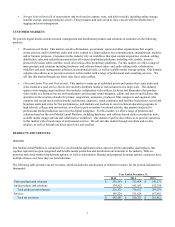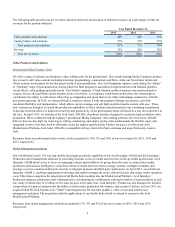Avid 2015 Annual Report Download - page 18
Download and view the complete annual report
Please find page 18 of the 2015 Avid annual report below. You can navigate through the pages in the report by either clicking on the pages listed below, or by using the keyword search tool below to find specific information within the annual report.12
• the need for our sales representatives to educate customers about the uses and benefits of our products and services,
including technical capabilities, security features, potential cost savings and return on investment, which are made
available in large-scale deployments,;
• the desire of large and medium size organizations to undertake significant evaluation processes to determine their
technology requirements prior to making information technology expenditures;
• the negotiation of large, complex, enterprise-wide contracts, as often required by our and our customers' business and
legal representatives;
• the need for our customers to obtain requisition approvals from various decision makers within their organizations; and
• customer budget constraints, economic conditions and unplanned administrative delays.
We spend substantial time and money on our sales efforts without any assurance that potential customers will ultimately purchase
our solutions. As we target our sales efforts at larger enterprise customers, these trends are expected to continue. Additionally, our
enterprise sales pattern has historically been uneven, where a higher percentage of a quarter's total sales occur during the final
weeks of each quarter, which is common in our industry. Our long sales cycle for these products makes it difficult to predict
when a given sales cycle will close.
Subscription offerings create risks related to the timing of revenue recognition.
We sell an increasing portion of our products based on a subscription model. Although the subscription model is designed to
increase the number of customers who purchase our products and services on a recurring basis and create a more predictable
revenue stream, it creates certain risks and uncertainties related to the timing of revenue recognition and potential reductions in
cash flows. A portion of the subscription-based revenue we report each quarter results from the recognition of deferred revenue
relating to subscription agreements entered into during previous quarters. A decline in new or renewed subscriptions in any period
may not be immediately reflected in our reported financial results for that period but may result in a decline in our revenue in
future quarters. If we were to experience significant downturns in subscription sales and renewal rates, our reported financial
results might not reflect such downturns until future periods. Our subscription model could also make it difficult for us to rapidly
increase our revenues from subscription-based services through additional sales in any period, as revenue from new customers
will be recognized over the applicable subscription term. Further, any increases in sales under our subscription sales model could
result in decreased revenues over the short term if they are offset by a decline in sales from perpetual license customers. If any of
our assumptions about revenue from our new businesses or our addition of a subscription-based model prove incorrect, our actual
results may materially differ from those anticipated, estimated or projected. We may be unable to predict subscription renewal
rates and the impact these rates may have on our future revenue and operating results.
If our customers do not renew their subscriptions for our services or if they renew on terms that are less favorable to us,
our revenues may decline
We sell Pro Tools, Media Composer and Sibelius on a subscription basis pursuant to service agreements that are generally month-
to-month or one year in length, and we intend to expand our subscription offerings to other products as well. Although many of
our service and subscription agreements contain automatic renewal terms, our customers have no obligation to renew their
subscriptions for our services after the expiration of their initial subscription period, and some customers elect not to renew. There
is a risk that these subscriptions will not be renewed at the same or a higher level of service, for the same number of seats/licenses
or for the same duration of time, or at all. Moreover, under certain circumstances, some of our customers have the right to cancel
their service agreements prior to the expiration of the terms of their agreements. We may not be able to accurately predict future
customer renewal rates. Our customers' renewal rates may decline or fluctuate as a result of a number of factors, including their
level of satisfaction with our services, the reliability of our subscription services, the prices of our services, the perceived
information security of our systems and services, the prices of services offered by our competitors, mergers and acquisitions
affecting our customer base, reductions in our customers' spending levels, or declines in customer activity as a result of economic
downturns or uncertainty in financial markets. If our customers do not renew their subscriptions for our services or if they renew
on terms less favorable to us, our revenues may decline. Our future growth is also affected by our ability to sell additional
features and services to our current customers, which depends on a number of factors, including customers' satisfaction with our
products and services, the prices of our offerings and general economic conditions. If our efforts to cross-sell and upsell to our
customers are unsuccessful, the rate at which our business grows may decline.
























